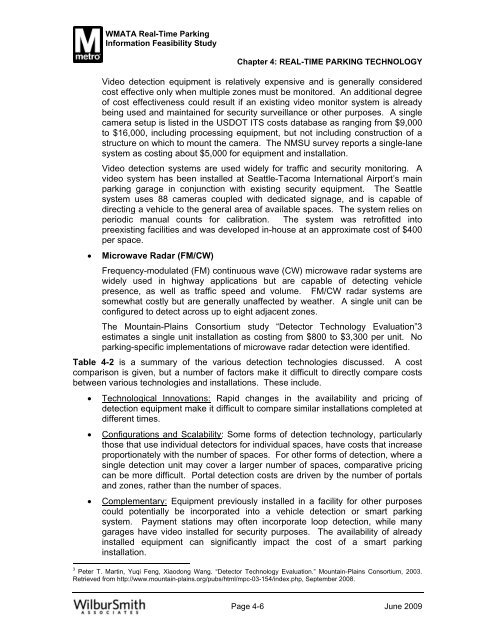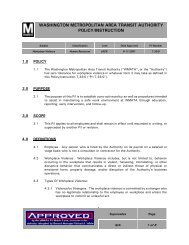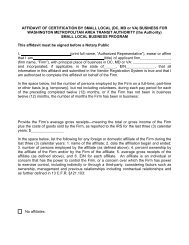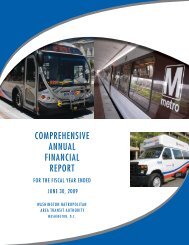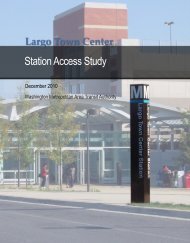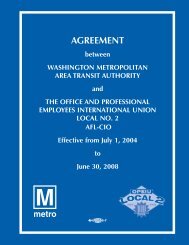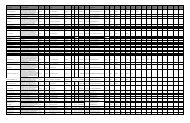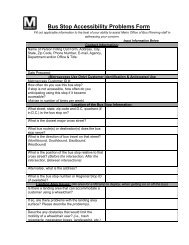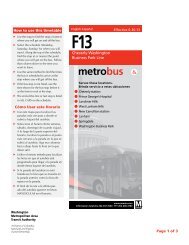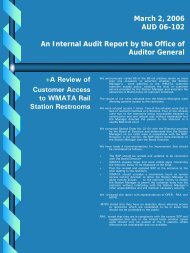feasibility study of real time parking information at ... - WMATA.com
feasibility study of real time parking information at ... - WMATA.com
feasibility study of real time parking information at ... - WMATA.com
Create successful ePaper yourself
Turn your PDF publications into a flip-book with our unique Google optimized e-Paper software.
<strong>WMATA</strong> Real-Time Parking<br />
Inform<strong>at</strong>ion Feasibility Study<br />
Chapter 4: REAL-TIME PARKING TECHNOLOGY<br />
Video detection equipment is rel<strong>at</strong>ively expensive and is generally considered<br />
cost effective only when multiple zones must be monitored. An additional degree<br />
<strong>of</strong> cost effectiveness could result if an existing video monitor system is already<br />
being used and maintained for security surveillance or other purposes. A single<br />
camera setup is listed in the USDOT ITS costs d<strong>at</strong>abase as ranging from $9,000<br />
to $16,000, including processing equipment, but not including construction <strong>of</strong> a<br />
structure on which to mount the camera. The NMSU survey reports a single-lane<br />
system as costing about $5,000 for equipment and install<strong>at</strong>ion.<br />
Video detection systems are used widely for traffic and security monitoring. A<br />
video system has been installed <strong>at</strong> Se<strong>at</strong>tle-Ta<strong>com</strong>a Intern<strong>at</strong>ional Airport’s main<br />
<strong>parking</strong> garage in conjunction with existing security equipment. The Se<strong>at</strong>tle<br />
system uses 88 cameras coupled with dedic<strong>at</strong>ed signage, and is capable <strong>of</strong><br />
directing a vehicle to the general area <strong>of</strong> available spaces. The system relies on<br />
periodic manual counts for calibr<strong>at</strong>ion. The system was retr<strong>of</strong>itted into<br />
preexisting facilities and was developed in-house <strong>at</strong> an approxim<strong>at</strong>e cost <strong>of</strong> $400<br />
per space.<br />
• Microwave Radar (FM/CW)<br />
Frequency-modul<strong>at</strong>ed (FM) continuous wave (CW) microwave radar systems are<br />
widely used in highway applic<strong>at</strong>ions but are capable <strong>of</strong> detecting vehicle<br />
presence, as well as traffic speed and volume. FM/CW radar systems are<br />
somewh<strong>at</strong> costly but are generally unaffected by we<strong>at</strong>her. A single unit can be<br />
configured to detect across up to eight adjacent zones.<br />
The Mountain-Plains Consortium <strong>study</strong> “Detector Technology Evalu<strong>at</strong>ion”3<br />
estim<strong>at</strong>es a single unit install<strong>at</strong>ion as costing from $800 to $3,300 per unit. No<br />
<strong>parking</strong>-specific implement<strong>at</strong>ions <strong>of</strong> microwave radar detection were identified.<br />
Table 4-2 is a summary <strong>of</strong> the various detection technologies discussed. A cost<br />
<strong>com</strong>parison is given, but a number <strong>of</strong> factors make it difficult to directly <strong>com</strong>pare costs<br />
between various technologies and install<strong>at</strong>ions. These include.<br />
• Technological Innov<strong>at</strong>ions: Rapid changes in the availability and pricing <strong>of</strong><br />
detection equipment make it difficult to <strong>com</strong>pare similar install<strong>at</strong>ions <strong>com</strong>pleted <strong>at</strong><br />
different <strong>time</strong>s.<br />
• Configur<strong>at</strong>ions and Scalability: Some forms <strong>of</strong> detection technology, particularly<br />
those th<strong>at</strong> use individual detectors for individual spaces, have costs th<strong>at</strong> increase<br />
proportion<strong>at</strong>ely with the number <strong>of</strong> spaces. For other forms <strong>of</strong> detection, where a<br />
single detection unit may cover a larger number <strong>of</strong> spaces, <strong>com</strong>par<strong>at</strong>ive pricing<br />
can be more difficult. Portal detection costs are driven by the number <strong>of</strong> portals<br />
and zones, r<strong>at</strong>her than the number <strong>of</strong> spaces.<br />
• Complementary: Equipment previously installed in a facility for other purposes<br />
could potentially be incorpor<strong>at</strong>ed into a vehicle detection or smart <strong>parking</strong><br />
system. Payment st<strong>at</strong>ions may <strong>of</strong>ten incorpor<strong>at</strong>e loop detection, while many<br />
garages have video installed for security purposes. The availability <strong>of</strong> already<br />
installed equipment can significantly impact the cost <strong>of</strong> a smart <strong>parking</strong><br />
install<strong>at</strong>ion.<br />
3<br />
Peter T. Martin, Yuqi Feng, Xiaodong Wang. “Detector Technology Evalu<strong>at</strong>ion.” Mountain-Plains Consortium, 2003.<br />
Retrieved from http://www.mountain-plains.org/pubs/html/mpc-03-154/index.php, September 2008.<br />
Page 4-6 June 2009


